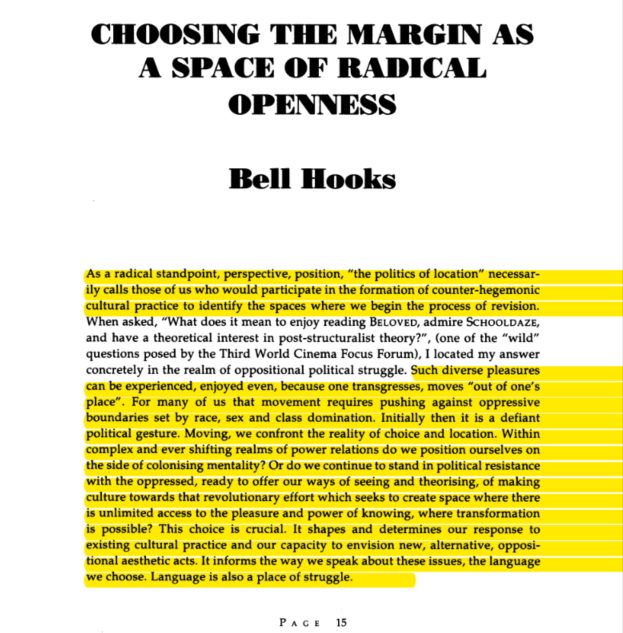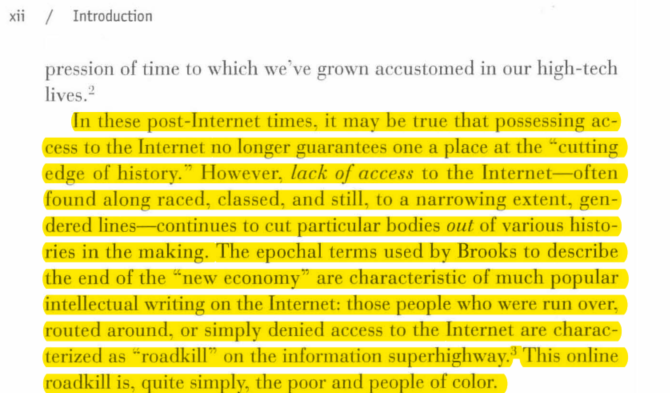There are multiple strands of thought I’m following and working through my findings at the moment. I usually do this by identifying the emotions that certain research materials stir up as I engage with them and then head off on a journey to locate its companions in a way. Imaginations of ‘what else might complement this’ guide how I proceed or retreat and the connections I end up making are often circuitous and serendipitous.
I attribute this to the sense of wonder I have for technology in general and the internet in particular. I have visceral memories of being enamored by the sheer power of being able to access random streams of knowledge that had nothing to do with school work as a kid and I’ve held on to these memories quite strongly. They help me determine when I stop the process of ‘making’ my works and how I determine if I am sufficiently intrigued by the things I create.
Here are some texts I’ve been reading, referencing and working with.

Choosing The Margin as a Space of Radical Openness – Bell Hooks
The above image shows an excerpt from the text ‘Choosing The Margin as a Space of Radical Openness by Bell Hooks’.
As a radical standpoint, perspective, position, “the politics of location” necessarily calls those of us who would participate in the formation of counter-hegemonic cultural practice to identify the spaces where we begin the process of revision. When asked, “What does it mean to enjoy reading Beloved, admire Schooldaze, and have a theoretical interest in post-structuralist theory?”, (one of the “wild” questions posed by the Third World Cinema Focus Forum), I located my answer concretely in the realm of oppositional political struggle. Such diverse pleasures can be experienced, enjoyed even, because one transgresses, moves “out of one’s place”. For many of us that movement requires pushing against oppressive boundaries set by race, sex and class domination. Initially then it is a defiant political gesture. Moving, we confront the reality of choice and location. Within complex and ever shifting realms of power relations do we position ourselves on the side of colonising mentality? Or do we continue to stand in political resistance with the oppressed, ready to offer our ways of seeing and theorising, of making culture towards that revolutionary effort which seeks to create space where there is unlimited access to the pleasure and power of knowing, where transformation is possible? This choice is crucial. It shapes and determines our response to existing cultural practice and our capacity to envision new, alternative, oppositional aesthetic acts. It informs the way we speak about these issues, the language we choose. Language is also a place of struggle.

Cybertypes: Race, Ethnicity, and Identity on the Internet – Lisa Nakamura
The above image shows an excerpt from the text “Choosing Cybertypes: Race, Ethnicity, and Identity on the Internet – Lisa Nakamura”
In these post-Internet times, it may be true that possessing access to the Internet no longer guara11tees one a place at the “cutting edge of history .. , However, lack of access to the Internet-often found along raced, classed, and still , to a narrowing extent, gendered lines-continues to cut particular bodies out of various hi stories in the making. The epochal terms used by Brooks to describe the end of the “new economy” are characteristic of much popular intellectual writing on the Internet: those people who were run over, routed around, or simply denied access to the Internet are characterized as “roadkill” on the information superhighway. This online roadkill is, quite simply, the poor and people of color.
A lot of the framing for my research is rooted in viewing technology through a sociological lens as a shared resource like the right to water/electricity we have as citizens in the physical world. This is especially amplified when tech development, conversations, frameworks and infrastructures intersect with administrative, governmental, bureaucratic and social structures. The intersectional points of these multiple domains are already fraught with erasure of communities whose identities and autonomy are constantly challenged. The communities located at these intersections are almost always the marginalised and people of colour. By not considering the needs and requirements of these communities and instead only creating capitalist intersectional points, technology does nothing else but replicate and amplify existing social biases towards caste, race, class, ethnicity, language etc. The promise of tech infrastructure serving as an equaliser is rendered false as it exacerbates the gulf between the different socioeconomic / socio-cultural positions of citizens and tech users.